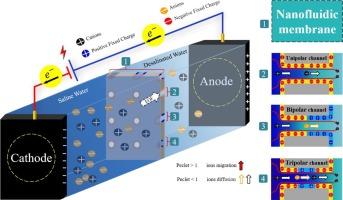纳米流体膜中的软层电荷调制:增强海水淡化的途径
IF 9.8
1区 工程技术
Q1 ENGINEERING, CHEMICAL
引用次数: 0
摘要
海水淡化是解决全球淡水短缺的关键挑战,而高效膜技术的发展对可持续的水净化至关重要。虽然纳米流体膜在能量转换方面显示出巨大的潜力,但其在海水淡化方面的应用仍未得到充分的探索。本研究模拟了圆柱形纳米流体膜去除水中LiCl、NaCl和KCl的性能,重点研究了软层电荷分布对离子截除效率的影响。检查了三种不同的电荷结构:单极(带负电荷),双极(带负电荷-带正电荷)和三极(带负电荷-带正电荷-带负电荷)。在稳态条件下对泊松-能斯特-普朗克方程和纳维-斯托克斯方程进行数值求解,分析静电相互作用、对流输运和外场应用对海水淡化性能的耦合影响。结果表明,得益于二极管整流和强离子耗尽区,双极纳米通道的脱盐效率最高。在30 bar的施加压力下,双极纳米通道在有电压时可以达到85% - 96%的阻盐率,无电压时可以达到50% - 89%,优于单极和三极结构。此外,双极纳米通道表现出优异的电流整流行为,在1 V下,LiCl的离子电流达到1.08 nA, NaCl达到1.25 nA, KCl达到1.60 nA,证实了增强的选择性。对Peclet数(Pe)和电解质浓度的进一步分析表明,在Pe≈0.05时,双极性纳米通道的NaCl截留率保持在95%以上,而单极和三极性纳米通道的选择性下降更明显,在Pe >时截留率降至50%以下;0.2和TMP >;80巴。这些发现强调了电荷调制在纳米流体膜中的重要影响,并强调了双极纳米通道在离子排斥和水渗透性之间提供了最有效的平衡。本文章由计算机程序翻译,如有差异,请以英文原文为准。

Soft layer charge modulation in nanofluidic membranes: A pathway to enhanced desalination
Water desalination is a critical challenge in addressing global freshwater scarcity, and the development of efficient membrane technologies is essential for sustainable water purification. While nanofluidic membranes have demonstrated great potential in energy conversion, their application in desalination remains underexplored. This study simulates the performance of cylindrical nanofluidic membranes in removing LiCl, NaCl, and KCl from water, focusing on the influence of soft layer charge distribution on ion rejection efficiency. Three distinct charge configurations were examined: unipolar (negatively charged), bipolar (negatively–positively charged), and tripolar (negatively–positively–negatively charged). The Poisson–Nernst–Planck and Navier–Stokes equations were numerically solved under steady-state conditions to analyze the coupled effects of electrostatic interactions, convective transport, and external field application on desalination performance. The results demonstrate that bipolar nanochannels achieve the highest desalination efficiency, benefiting from diode-like rectification and strong ion depletion zones. At an applied pressure of 30 bar, the bipolar nanochannel achieves 85 %–96 % salt rejection with voltage and 50 %–89 % without voltage, outperforming the unipolar and tripolar configurations. Additionally, the bipolar nanochannel exhibits superior current rectification behavior, with ionic currents reaching 1.08 nA for LiCl, 1.25 nA for NaCl, and 1.60 nA for KCl at 1 V, confirming enhanced selectivity. Further analysis of the Peclet number (Pe) and electrolyte concentration reveals that bipolar nanochannels maintain NaCl rejection above 95 % at Pe ≈ 0.05, whereas unipolar and tripolar configurations experience a sharper decline in selectivity, with rejection dropping below 50 % at Pe > 0.2 and TMP > 80 bar. These findings underscore the significant impact of charge modulation in nanofluidic membranes and highlight that bipolar nanochannels provide the most effective balance between ion rejection and water permeability.
求助全文
通过发布文献求助,成功后即可免费获取论文全文。
去求助
来源期刊

Desalination
工程技术-工程:化工
CiteScore
14.60
自引率
20.20%
发文量
619
审稿时长
41 days
期刊介绍:
Desalination is a scholarly journal that focuses on the field of desalination materials, processes, and associated technologies. It encompasses a wide range of disciplines and aims to publish exceptional papers in this area.
The journal invites submissions that explicitly revolve around water desalting and its applications to various sources such as seawater, groundwater, and wastewater. It particularly encourages research on diverse desalination methods including thermal, membrane, sorption, and hybrid processes.
By providing a platform for innovative studies, Desalination aims to advance the understanding and development of desalination technologies, promoting sustainable solutions for water scarcity challenges.
 求助内容:
求助内容: 应助结果提醒方式:
应助结果提醒方式:


